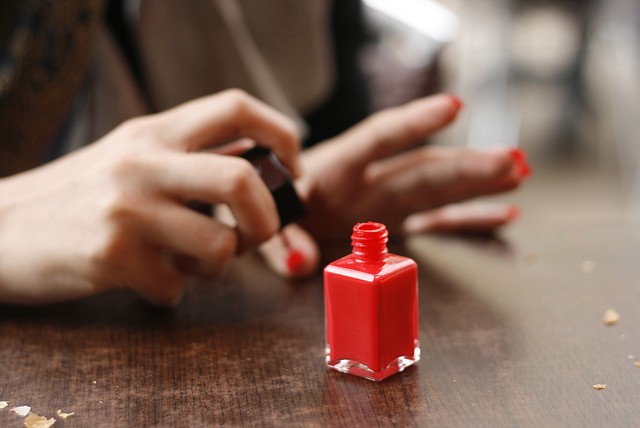Getting Your Nails Did, Then And Now
by Angela Serratore

In 1879, the Chicago Tribune’s ‘Gossip for Ladies’ columnist reported upon the beauty and grooming practices of the Eastern elite:
“The person who, alone in New York, makes a specialty of attending to the finger-nails, lives in handsome quarters on Twenty-third street, near Booth’s Theatre. There a Sun reporter found her, in a large and richly furnished parlour. ‘My principal customers are ladies of wealth and refinement. All the members of four of the wealthiest families of New York, from the children up to the grandparents, come to me once a week. It is not true, you know, that nails grow beautiful and perfect naturally.’”
The manicurist, who would make house calls were it not for the fact that her tool case is so heavy, is coy about which ladies come more than once a week and which ladies have problem nails (if you think those US Weekly exposés on which celebrities have problem thighs and which trainers get paid astronomical sums to fix them are a modern invention, you are sorely mistaken), but she does let slip that for the hour-long procedure — an 1897 manicure followed virtually the same ‘clean, trim, varnish’ process in use today, minus quick-drying chemicals — she charged the sum of one and a half dollars (no mention of tip).
In 2012 money, that’s about forty bucks, though what’s more important is that at the time, the average Manhattan working woman earned a dollar and a half a week — if she was lucky. A shopgirl in one of the better department stores might’ve been able to afford a manicure once a year, if it was something that even occurred to her, which it probably didn’t, because paying someone to clean and paint your nails was, in 1897, a luxury, and luxuries are called luxuries because regular people can’t afford them.
By the mid 1950s, nail polish was something you could buy at the drugstore, and brands like Max Factor and Maybelline urged women to paint their nails just like their favorite Hollywood celebrities (who had on-set manicurists, natch!), and by the time acrylic nails (invented by a Philadelphia-area dentist using teeth-bonding technology) took off in the early 60s, the idea of not having your nails “done” was unthinkable to large swaths of women. A bizarre-yet-well-meaning campaign by Hitchcock blonde Tippi Hedren to have Vietnemese refugee women educated in the nail trade by her own personal manicurist (the charity organization Boat People SOS gave her an award last year and everything!) is largely seen in the business as the jumping-off point for the explosion of nails-only salons, especially in cities that remain destinations for both large immigrant populations and women who have money to spend.
There are, according to Nails Magazine (the publications of the beauty-industrial complex — free dissertation topic, you’re welcome), 3,800 nail salons in New York State (and 2,600 in New Jersey!) charging, on average, fifteen dollars for a regular manicure, though that’s getting lower — a visit to a sampling of Manhattan salons undertaken as research unearthed five establishments charging eight dollars, three charging seven, and two charging ten, though the ten-dollar salons offered me a discount with student ID or for coming in before noon.
The idea that some things get cheaper while others get more expensive isn’t a new one — that’s the big takeaway from the Industrial Revolution, right? The things that get cheaper, though, aren’t food or shelter or transportation. They’re the aforementioned luxuries, only now because we, and by we I mean women who aren’t daughters of Manhattan’s four most famous families, can afford them, they’re framed as necessities. (I should also point out that many barbershops did and do offer manicures, and in the early part of the 20th century it was rare to meet a businessman who didn’t get a nail buffing along with his shave.)
Last week, I paid seven dollars plus tip to have my nails done at a salon across the street from my apartment — I don’t remember the salon’s name, because there are, in fact, five nail salons on my block, which is nowhere near 23rd St. The total price came out to twenty-two cents in 1897 American money.
Angela Serratore would rather live in the past, except it was so smelly back then. Photo Credit: flickr/zitona
Support The Billfold
The Billfold continues to exist thanks to support from our readers. Help us continue to do our work by making a monthly pledge on Patreon or a one-time-only contribution through PayPal.
Comments